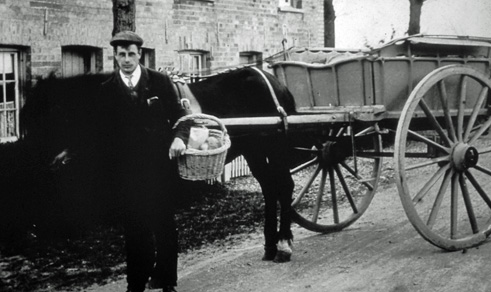Samuel Froment was born in 1888 in Swavesey, Cambridgeshire. His parents were Arthur, a farm labourer and Caroline (née Prior). Caroline died two years after Samuel’s birth, leaving Arthur to bring up his young family with the assistance of his mother-in-law. In 1901, Samuel was thirteen years old and employed as a baker’s apprentice. By 1911, he had become a baker and at some point during his career, he worked for Mr William Key who ran the bakery on the High Street in Swavesey.
Samuel was also a keen cricketer and a bowler for the Swavesey Cricket team; while he played with them, the team won the local cricket cup for two successive seasons, in 1912 and 1913. In 1914, Samuel answered an advertisement in a local paper placed by St Audry’s looking for sportsmen to join as attendants, with responsibility for teaching the patients games. Samuel duly applied for a position and started work on 15th July 1914— but he was not there long.
On 4th August 1914, the day war was declared, Samuel enlisted in the Army Service Corps (ASC) to work as a baker. Just over a month later on 15th September, he married Mabel Warren. Mabel is believed to have been born in Newbridge, Monmouthshire in Wales. At that time, she was working as at St Audry’s Hospital. After the wedding, the couple moved to Samuel’s home village of Swavesey.
On 31st March 1916, Samuel requested a transfer from the ASC into a regular infantry battalion, which was granted, and he was temporarily attached to the Border Regiment. On September 20th, 1916, Mabel gave birth to their daughter, Grace Gwendoline, in Swavesey. Sadly, Grace died only five weeks after her birth.
Samuel was sent overseas on 28th June 1917: he spent the first three weeks in an infantry depot camp. On the 19th July, Samuel was posted to join the 10th Battalion, The Queen’s (Royal West Surrey Regiment), based in the Ypres Salient. Days later, on the 31st July 1917, the Third Battle of Ypres, or Passchendaele, began. Six days after the battle started, the battalion was in trenches at Hollenbecke, a short distance away from Hill 60, one of the few high points in the Ypres.
The battalion war diary entry for 5th August reads:
“Heavily shelled all day. At about 9:30 pm the enemy attacked at Hollenbecke on both sides. Artillery and machine guns fired S.O.S. No enemy were then seen advancing on our front and as they attacked on both flanks it would seem that they were held up by our artillery and machine gun fire. Severe casualties.”
Samuel was one of the casualties, killed in action less than six weeks after setting foot on the continent. His company’s commander wrote to his widow, Mabel:
"It is with extreme sorrow that I have to inform you that your husband, Pte S.J.Froment, was killed in action on the 5th August while doing his duty. He had not been with the company very long, but it was long enough to prove him a good and willing soldier, and his loss will be felt by all of the company. He was killed instantaneously and was buried within our lines."
Samuel’s grave was later destroyed by the ongoing fighting during the Third Battle of Ypres and his body was not found. He is commemorated on the Menin Gate Memorial, the War Memorial in St Andrew’s Church, Swavesey, and Melton War Memorial. For his war service, his family received his British War and Victory Medals. Mabel returned to her native South Wales where, in 1920, she married Thomas John Jones. In 1939, they were living with their four children in Abercarn, Monmouthshire.

